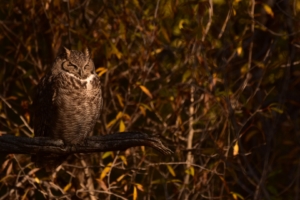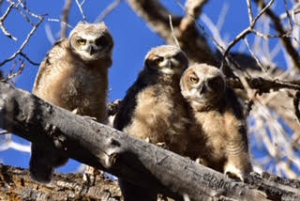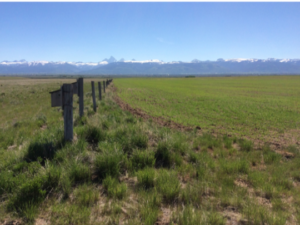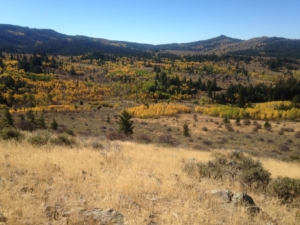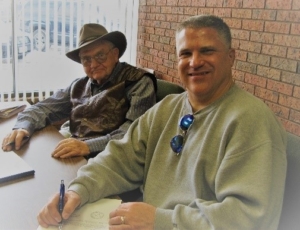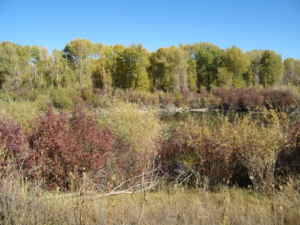(December 22, 2020) Last week, the Teton Regional Land Trust (TRLT) and Teton County, Idaho completed the most recent conservation easement along the Teton Creek Corridor. The property borders Teton Creek north of Cemetery Road and was once a proposed site for Teton County’s new Road and Bridge Facility. After deciding not to build there, the county considered selling the property to help finance a new site but decided instead to work with the Teton Creek Collaborative (TCC) to protect the property from future development by selling a conservation easement. The proceeds will be used to help fund the new Road and Bridge facility without having to sell public land along Teton Creek. The property will remain in Teton County ownership with a conservation easement held by Teton Regional Land Trust. The conservation easement preserves the open space along the Teton Creek Corridor and allows for public access along a gravel pathway. The intended recreational uses for the pathway include biking, walking, and horseback riding with a winter closure to provide secure and undisturbed habitat for wintering big game. “Teton County is proud to be a partner in this collaborative effort to restore and conserve the Teton Creek Corridor for the benefit of our community,” said Cindy Riegel, Teton County, Idaho County Commissioner.
Over a one-half mile of Teton Creek flows through the property. Mature cottonwoods, aspens, and other riparian shrubs line the creek corridor. The property’s natural features also include sagebrush steppe which provides habitat for a number of wildlife species including wintering elk, white-tailed deer, and moose. Mountain lions, black bears, and other mammals frequent the creek corridor, and the area supports raptor species such as Great Gray Owl, Great Horned Owl, and Bald Eagle, along with numerous songbirds. “For a relatively small property, it has quite a bit of Teton Creek frontage, which is great for both the scenery and wildlife habitat value. Conserving this property keeps it free from residential and industrial development while providing a unique opportunity for the community to recreate in a natural setting close to town while limiting winter public access to benefit wildlife,” said Renee Hiebert, TRLT.
The Teton Creek Collaborative, a partnership that includes the Teton Regional Land Trust, Friends of the Teton River (FTR), Valley Advocates for Responsible Development (VARD), Teton Valley Trails and Pathways (TVTAP), and LegacyWorks Group (LWG) formed in 2015 to work with other interested non-profits, municipalities, and community members to fulfill the vision put forth in the Teton County Comprehensive Plan. This vision aligned with the goals of the TCC including habitat protection and restoration, farmland protection, public pathway, and incentive-based options to reduce development within and along the corridor. “Less than two years ago, an industrial facility was proposed on this site. Now it is protected forever. This is the result of determination, collaboration, and community-driven conservation,” said Shawn Hill, VARD.
The project conserves open space for the general public to enjoy the property’s natural surroundings and the Teton Creek trail system. Establishing the public pathway along Teton Creek has been years in the making. Since 2015 TCC has been working with private property owners, Teton County, and the City of Driggs to negotiate and establish a public pathway easement between Cemetery and Stateline Roads. Once the access easements were in place, TCC, led by Teton Valley Trails and Pathways, set out to raise funds for pathway construction.
This past year, the pathway was constructed through Teton County’s property and the Land Trust’s land upstream of Cemetery Road. The partners are still working to raise the funds to connect the path all the way to Stateline Road, but are excited to share that the trail will be opening in 2021 once winter range closures are lifted. In working to balance habitat protection for wildlife with public access for our community, the pathway has been sited along the upland bench and outside the corridor to provide safety and security for wildlife. The pathway will be closed during the winter to ensure animals, like the wintering elk, have a secure space free of disturbance during that critical time for their survival.
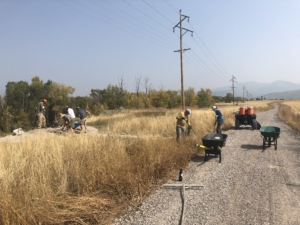 “During the summer 2020 construction season, TVTAP completed 1.6 miles of finished gravel pathway. In 2021 TVTAP will complete the final 0.4 miles of the pathway. Work also will begin on a pedestrian bridge over Teton Creek to improve pathway connectivity and safety between Ski Hill and Cemetery Roads,” said Dan Verbeten, TVTAP.
“During the summer 2020 construction season, TVTAP completed 1.6 miles of finished gravel pathway. In 2021 TVTAP will complete the final 0.4 miles of the pathway. Work also will begin on a pedestrian bridge over Teton Creek to improve pathway connectivity and safety between Ski Hill and Cemetery Roads,” said Dan Verbeten, TVTAP.
Since this collaboration began, significant progress has been made, collectively achieving impressive results including in-stream restoration of Teton Creek, permanent protection of over 300 acres, and the establishment of pathway connectivity between Driggs and Stateline Road. Achieving the goals of the TCC is a balancing act, and the collaborative has worked hard to incorporate the desire of the community to have the ability to access nature close to Driggs while also protecting habitat for wildlife, improving flood protection, and sustaining open space and productive agricultural lands. “It’s incredible to realize how much progress has been made on this project in such a short time. At Friends of the Teton River, we are really excited about the way this project will make it possible for people to connect with the Teton Creek corridor, and to learn about all of the community benefits of protecting healthy, functioning stream channels and floodplains,” said Amy Verbeten, FTR. The Teton Creek Collaborative is excited to welcome the community to the site when the pathway opens this spring once the winter closure is lifted. For more information visit tetoncreekproject.org.
The LOR Foundation has taken a lead role in empowering the community organizations to make this project possible through their generous financial support of this conservation easement. Additional support for the conservation easement came from an agreement between Grand Targhee Resort and Teton County, Wyoming. Numerous other granting entities and individual donors including the Community Foundation of Teton Valley have generously supported other aspects of the project. “Many thanks to the visionary funders, government partners, and nonprofit leaders in our community and beyond who made this all possible. From the LOR Foundation’s initial support to all the private and public funding that followed from there, the Teton Creek Corridor project brought millions of dollars into the valley to achieve one of the community’s long-standing goals – protecting wildlife and agriculture, restoring habitat, and creating recreational access and safe pathways,” said Carl Palmer, LWG.
Wildlife Photos in Teton Creek Corridor by Marty Edwards
